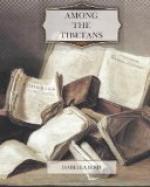In the usual living-room of the family a platform, raised only a few inches, ran partly round the wall. In the middle of the floor there was a clay fireplace, with a prayer-wheel and some clay and brass cooking pots upon it. A few shelves, fire-bars for roasting barley, a wooden churn, and some spinning arrangements were the furniture. A number of small dark rooms used for sleeping and storage opened from this, and above were the balconies and reception rooms. Wooden posts supported the roofs, and these were wreathed with lucerne, the firstfruits of the field. Narrow, steep staircases in all Tibetan houses lead to the family rooms. In winter the people live below, alongside of the animals and fodder. In summer they sleep in loosely built booths of poplar branches on the roof. Gergan’s roof was covered, like others at the time, to the depth of two feet, with hay, i.e. grass and lucerne, which are wound into long ropes, experience having taught the Tibetans that their scarce fodder is best preserved thus from breakage and waste. I bought hay by the yard for Gyalpo.
Our food in this hospitable house was simple: apricots, fresh, or dried and stewed with honey; zho’s milk, curds and cheese, sour cream, peas, beans, balls of barley dough, barley porridge, and ‘broth of abominable things.’ Chang, a dirty-looking beer made from barley, was offered with each meal, and tea frequently, but I took my own ‘on the sly.’ I have mentioned a churn as part of the ‘plenishings’ of the living-room. In Tibet the churn is used for making tea! I give the recipe. ’For six persons. Boil a teacupful of tea in three pints of water for ten minutes with a heaped dessert-spoonful of soda. Put the infusion into the churn with one pound of butter and a small tablespoonful of salt. Churn until as thick as cream.’ Tea made after this fashion holds the second place to chang in Tibetan affections. The butter according to our thinking is always rancid, the mode of making it is uncleanly, and it always has a rank flavour from the goatskin in which it was kept. Its value is enhanced by age. I saw skins of it forty, fifty, and even sixty years old, which were very highly prized, and would only be opened at some special family festival or funeral.
During the three days of our visits to Hundar both men and women wore their festival dresses, and apparently abandoned most of their ordinary occupations in our honour. The men were very anxious that I should be ‘amused,’ and made many grotesque suggestions on the subject. ‘Why is the European woman always writing or sewing?’ they asked. ‘Is she very poor, or has she made a vow?’ Visits to some of the neighbouring monasteries were eventually proposed, and turned out most interesting.




